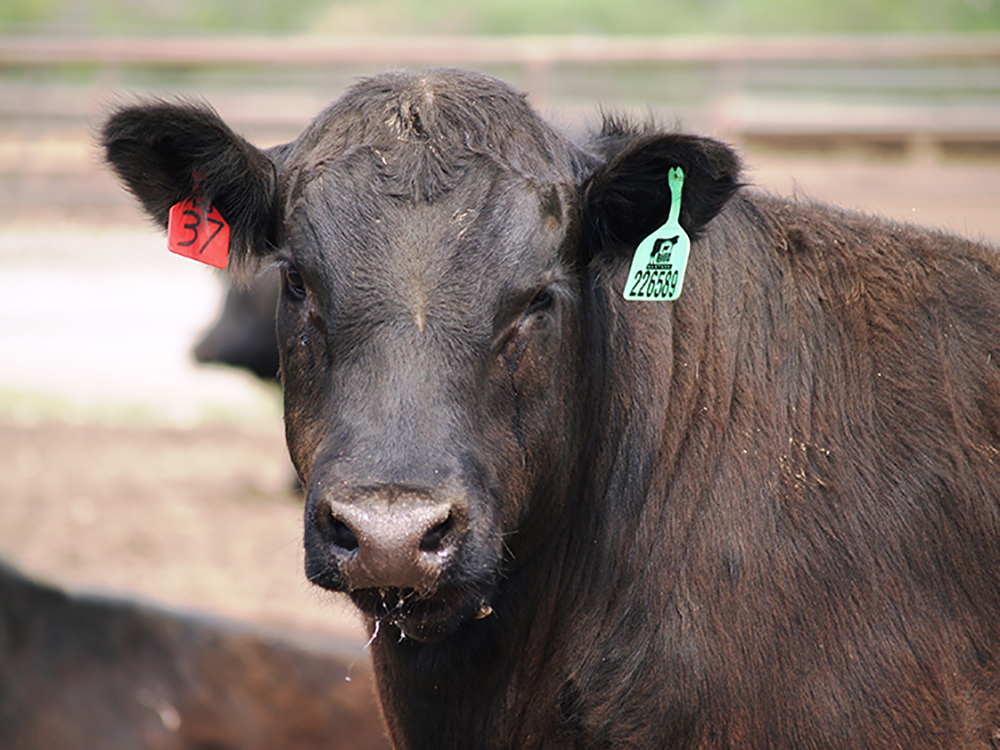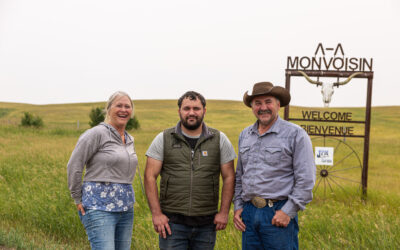
What the value-based beef market values
by Trish Henderson
With beef at record high prices in North America and around the world, consumers are seeking premium products to ensure their money is well spent. That’s one reason the Certified Angus Beef ® (CAB) brand joined with the Canadian Angus Association to sponsor “Carcass 101” June 18-19 in Olds, AB.
Those record highs point to an industry future more dependent than ever on its ability to consistently deliver a quality eating experience. Genetics and management have a big effect on that, which is why Carcass 101 put much focus on how to deliver the best quality profitably.
Thirty-one cattle producers from across the Prairie Provinces attended the workshop in the National Meat Training Centre at Olds College. The world-class facility hosts the only course in North America that covers the whole supply chain from slaughter to retail.
The class visually appraised three steers, then evaluated and graded their carcasses the next day. Meanwhile, guest speakers covered beef grading, meat cutting, genetics, ultrasound, consumer trends and best-practices at the cow-calf and feedlot levels.
Dr. Phil Bass, CAB meat scientist, reviewed the key carcass characteristics evaluated by beef graders in North America:
- Physiological maturity of a carcass (indicated by dentition or ossification) is important because older animals have more connective tissue, which affects tenderness, and age is a qualifier for many export markets, he noted.
- External fat thickness at the 12th rib and ribeye area are used to calculate yield grades, but ribeye size is also an issue in the foodservice sector. Steaks that are similar in size and thickness mean a more consistent product for diners, Bass said.
- Muscling, meat color, fat depth and marbling are components of quality grade scores, and marbling is a kind of insurance policy for that satisfactory eating experience, he said.

The trend includes more transparency and higher quality. All cattle Tyson sources are required to come from Beef Quality Assurance (BQA) certified suppliers by January 1, 2019.
“We’ve got to be transparent. We’ve got nothing to hide,” Gerber said.
Nigel Gopie, of IBM Food Trust, said sharing will get easier.
“A transparent food system matters,” he said. “Today we’re seeing a blurry view—80% of the world’s data is locked up in organizations’ databases. Only 20% is available through things like Google.”
The IBM Food Trust looks to change that using blockchain technology to assign each data point a fingerprint, or “hash,” so users know the information source and that it’s in its original form.
A handful of large food companies from Walmart to Dole currently use blockchain, but it will take innovative thinking to get the masses onboard.
That’s exactly what veterinarian Sam Barringer, a commander on the Air Force Reserves medical team, suggested we need more of: out-of-the-box thinking.
“We’ve been doing the same things the same way for 20 years and we don’t even know why we’re doing it,” he said, drawing on his experience in Middle East war theaters.
Cattlemen can’t look at health and vaccination as synonymous, Barringer said. “If we were to vaccinate for every pathogen facing cattle, it would be 32 vaccines upon arrival. That’s not viable.”
Even the standard health protocols need some scrutiny, said Paul Walz, Auburn University veterinarian.
“We are at a point with evolving BVD that some of our vaccines no longer provide the same amount of protection,” he said, noting a survey of Nebraska calves showed 82% of BVD strains were outside of those on which vaccines are based. Risk varies from herd to herd and strategies may need to vary year to year.
Regardless of vaccine strain, the stress on newly arrived cattle at any feedyard can hinder efficacy, said Brian Vander Ley, epidemiologist at Nebraska’s Great Plains Veterinary Education Center.
“Vaccines are intended for use in healthy cattle,” he said. On arrival, some calves are too stressed to meet that practical definition. University of Arkansas data on high-risk calves showed an advantage to waiting a couple of weeks before administering those shots.

“Go home and talk to your folks, and make sure you’re doing the right things,” said nutritionist Jeff Heldt, with Micronutrients.
Referring to conversations about cattle supplement timing, storage and delivery, he said vitamins are finicky. They don’t like environments that are too hot, acidic, light or wet.
“Feed manufacturers do a good job meeting mineral needs, but storage time of our products is pretty critical,” Heldt said.
Nutrition on the ranch, must be continued with a solid plan in the feedyard.
Dale Blasi, Kansas State University animal scientist, suggested feeders ask their consultants about limit feeding a grain-based ration to calves at 2.2% of their body weight.
K-State work shows many benefits, from decreased cost of gain and better health to reduced labor and manure management.
It was common practice two or three decades ago. It might be time to revisit the strategy, Blasi said: “Something that’s been so in vogue for so long, working, why didn’t we stay with it?”
The world of nutrition may change slowly over time, but markets are the opposite.
Dan Basse, president of AgResource Co., returned to the forum to talk global markets and the causes of volatility.
“The world is really, really focused today on politics,” he said. He predicted fed cattle prices of up to $120 per hundredweight in the fourth quarter, nothing the model did not account for a trade deal with China in the near future. “If that happens, it changes a lot,” he said. “That’s our big hope in terms of the U.S. opportunity, to build demand and really get back to a bull market longer term.”
During the evening reception, longtime Nebraska cattle feeder Gerald Timmerman accepted the Industry Achievement Award.
“Gerald has a long history of putting the consumer first, and using technology and innovation to do it,” said Mark McCully, CAB vice president of production. “We’re proud to honor him.”
You may also like
Drought Impact and Cattle Industry Dynamics
As drought conditions persist across much of cattle country, farmers and ranchers are at a pivotal juncture in the cattle industry’s landscape. What impact does this prolonged dry spell have on the nation’s herd numbers? When will heifer retention begin? How will industry dynamics influence the spring bull sale season?
Saskatchewan Angus Ranch Earns Certified Angus Beef Award
JPM Farms in Canada quietly gained recognition for its dedication to environmental sustainability and quality cattle. The Monvoisin family earned the 2023 CAB Canadian Commitment to Excellence award for their outstanding results and partnership with Duck Unlimited, showcasing their commitment to improving the land, cattle and family daily.
Feeding Quality Forum Shares Market Outlook, Path to Meeting Demand
The beef demand success story of the past is also the industry’s roadmap for the future, said speakers at this year’s Feeding Quality Forum. The program covered everything from current market conditions and technology to price forecasts and advancements on the horizon.



